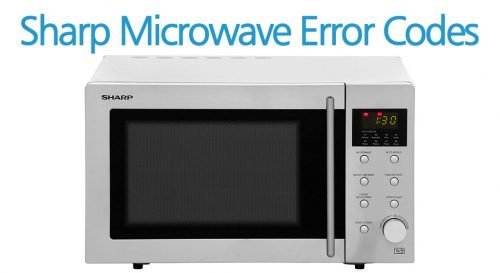
Microwaves, like other appliances, have built-in error codes to diagnose and alert users to various issues. The “OE” error code, specifically for Sharp microwaves, usually indicates a more serious problem. You might think of it as your microwave saying, “Hey, something isn’t working the way it should!” It’s tempting to ignore this, hoping it will go away or resolve itself, but that’s often not the case. Ignoring it could lead to further complications down the line, just like ignoring a small leak under your sink could cause water damage or mold. So, let’s dive deeper into what this means and what you can do about it.
Understanding the Meaning of Error Code OE
So, what’s the story behind this “OE” error code? In most Sharp microwaves, the “OE” code is related to problems with the oven temperature sensor. Imagine the sensor as the thermostat in your house. Its job is to monitor the temperature. If it’s not working correctly, the microwave can’t tell how hot things are getting. This can be particularly concerning because it affects how evenly and safely your food cooks.
A malfunctioning temperature sensor might cause the microwave to overheat, which could make food safety a concern. Think of it like leaving your oven on too high for too long—it’s not just about overcooked food; there’s a risk of fire or other damage. Similarly, if the sensor reads an incorrect temperature, your microwave might believe it’s too hot and shut down to prevent overheating. It’s a safeguard, yes, but also an indication that it requires your attention.
If you’re experiencing the “OE” error, ignoring it isn’t advisable. While it might be tempting to wave it off, like a dismissive acknowledgement of a low phone battery alert, failing to address the issue can lead to greater problems. Your microwave’s lifespan could be shortened, and more importantly, its safe operation could be compromised. So, acknowledging this error is the first step towards a solution.
Common Causes of the OE Error
You might be wondering, “Why is this happening to my microwave?” There are several potential culprits behind the “OE” error code. One common cause is a faulty temperature sensor. Over time, like any electronic component, sensors can wear out or get damaged. It’s akin to a pencil gradually wearing down to the nub—eventually, it just can’t do its job anymore.
Another possible reason is a problem with the microwave’s wiring. If the wires connected to the sensor are loose or damaged, it can lead to faulty readings and trigger the error code. It’s like trying to run an electric train on a track with a loose rail—sooner or later, there’s bound to be a derailment. Lastly, a malfunction in the microwave’s control board might be at fault. Think of the control board as the brain of your microwave. If it’s confused, the messages it sends internally, such as managing temperature, can get garbled and set off errors.
Understanding these common causes helps you visualize potential next steps. While you might not be a repair expert, knowing what’s potentially wrong can guide you in deciding whether to attempt a fix yourself or call in a professional.
How to Address and Fix the Error
Facing a scary error code doesn’t mean you’re stuck with a microwave that doubles as a kitchen ornament. Here’s the deal: addressing the “OE” error code might be simpler than you think. The first thing to try is a basic reset. Unplug the microwave, wait a few minutes, and then plug it back in. This can sometimes clear the error if it was a temporary glitch, much like rebooting a frozen computer.
If the error persists, inspecting the temperature sensor is the next logical step. While handling electronics, always ensure the appliance is unplugged to prevent any electric shock. If you’re comfortable, try locating the sensor (consult your microwave’s manual for guidance) and checking for any visible damage or loose connections. Alternatively, if this feels out of your comfort zone, it might be wise to contact a professional technician. They’ll have the tools and expertise to diagnose the issue accurately.
Prevent-wise, consider regular maintenance to keep your microwave happy and error-free. Clean it regularly, avoid slamming the door (which can jostle internal components), and keep an eye out for any signs of wear and tear. Like keeping your car in tune, a little attention can go a long way in preventing future headaches.
Final Thoughts
Ultimately, when it comes to the “OE” error code on your Sharp microwave, ignoring it isn’t the best route. While it might seem like a small issue now, leaving it unaddressed can lead to more serious problems down the road, akin to letting a small crack in the windshield spider into something much bigger. Tackling this error can be empowering—you’re taking charge of your kitchen and ensuring that everything runs smoothly.
If you’re unsure about what steps to take, don’t hesitate to consult a professional. They can provide peace of mind and help maintain your microwave in optimal condition. And remember, regular care and attention can prevent many such issues, ensuring your microwave continues to serve up hot meals without a hitch.